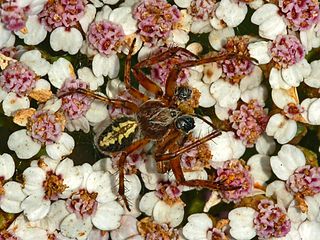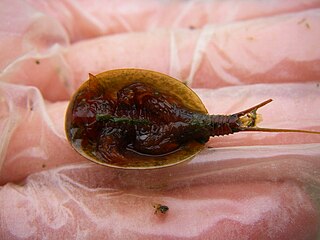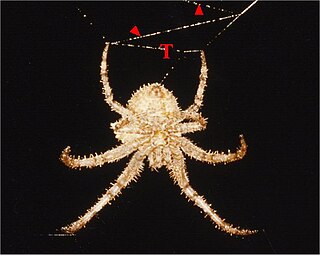
Huntsman spiders, members of the family Sparassidae, catch their prey by hunting rather than in webs. They are also called giant crab spiders because of their size and appearance. Larger species sometimes are referred to as wood spiders, because of their preference for woody places. In southern Africa the genus Palystes are known as rain spiders or lizard-eating spiders. Commonly, they are confused with baboon spiders from the Mygalomorphae infraorder, which are not closely related.

The Araneomorphae are an infraorder of spiders. They are distinguishable by chelicerae (fangs) that point diagonally forward and cross in a pinching action, in contrast to the Mygalomorphae, where they point straight down. Araneomorphs comprise the vast majority of living spiders.

The Pholcidae are a family of araneomorph spiders. The family contains more than 1,800 individual species of pholcids, including those commonly known as cellar spider, daddy long-legs spider, carpenter spider, daddy long-legger, vibrating spider, gyrating spider, long daddy, and angel spider. The family, first described by Carl Ludwig Koch in 1850, is divided into 94 genera.

The Tortricidae are a family of moths, commonly known as tortrix moths or leafroller moths, in the order Lepidoptera. This large family has over 11,000 species described, and is the sole member of the superfamily Tortricoidea, although the genus Heliocosma is sometimes placed within this superfamily. Many of these are economically important pests. Olethreutidae is a junior synonym. The typical resting posture is with the wings folded back, producing a rather rounded profile.

Crevice weaver spiders (Filistatidae) comprise cribellate spiders with features that have been regarded as "primitive" for araneomorph spiders. They are weavers of funnel or tube webs. The family contains 18 genera and more than 120 described species worldwide.

Anton Ausserer was an Austrian naturalist specialising in spiders. His father died when he was a youth, and he and his family suffered much economic hardship, but he was supported and encouraged by Camill Heller, professor of Zoology and Comparative Anatomy at the University of Innsbruck.

Psechridae is a family of araneomorph spiders with about 70 species in two genera. These are among the biggest cribellate spiders with body lengths up to 2 centimetres (0.79 in) and funnel webs more than 1 metre in diameter.

Aculepeira ceropegia, the oak spider, is an orb-weaving spider species belonging to the family Araneidae.

Aculepeira is a genus of orb-weaver spiders first described by R. V. Chamberlin & Wilton Ivie in 1942.

Lepidurus packardi, the vernal pool tadpole shrimp, is a small, rare species of tadpole shrimp (Notostraca) found in temporary ponds of the western United States.

Kaira, sometimes called frilled orbweavers, is a mostly neotropical genus of orb-weaver spiders first described by O. Pickard-Cambridge in 1889. It includes sixteen described species that occur from South America up to the southern and eastern USA. It is presumably related to Aculepeira, Amazonepeira and Metepeira.

Aculepeira carbonarioides is a spider in the orb-weaver family (Araneidae).

Cyclophora packardi, Packard's wave moth or Packard's wave, is a moth in the family Geometridae. It is found in North America, from Maine to Florida, west to Texas and north to Iowa and Ohio.
Aculepeira lapponica is an orb-weaving spider found in Sweden, Finland and Russia.
Aculepeira talishia is an orb-weaving spider species found in Turkey, Russia, Georgia and Azerbaijan.

Alireza Zamani is an Iranian arachnologist and taxonomist.
Dubiepeira is a genus of South American orb-weaver spiders first described by Herbert Walter Levi in 1991.

Taracidae is a family of harvestmen in the order Opiliones. There are 4 genera and 23 described species in Taracidae.
Taracus packardi is a species of harvestman in the family Taracidae. It is found in North America.

Hesperonemastoma is a genus of harvestmen in the family Taracidae. There are about five described species in Hesperonemastoma.

















